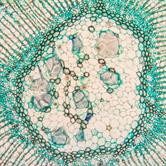The shoot apical meristem (SAM) ensures the continuous generation of new organs, such as leaves, lateral shoots, inflorescences, and flowers, throughout the life of the plant. The SAM, which arises during embryogenesis, contains undifferentiated pluripotent cells that form the stem cell niche. Some of the progeny differentiate into new organs and tissues, while others maintain the niche reservoir. Thus, the SAM maintains a balance between cells that divide to generate new organs and those that remain totipotent, which is crucial for the development of aboveground plant structures.
Recent decades have seen great advances in our understanding of the regulatory networks that maintain the SAM, which include regulatory genes (e.g., homeodomain transcription factors such as WUSCHEL), signaling peptides and receptors (e.g., the CLAVATA pathway), and key hormones (e.g., auxins and cytokinins).
Manipulating the SAM offers a variety of biotechnological possibilities. The application of morphogenetic regulators (e.g., WUS and BABY BOOM genes) can improve the efficiency of plant transformation and regeneration, even in recalcitrant species and cultivars (Boutilier et al., 2002; Lowe et al., 2016). Furthermore, traits such as yield, flower and fruit number, and stress tolerance are influenced by the activity of the SAM and floral meristems (Fletcher, 2018). Understanding the mechanisms of the SAM can help us better tune and modify these traits.
This Research Topic aims to collect cutting-edge research on innovative manipulation of the apical meristem for improved biotechnology across plants, algae, and simpler organisms.
We welcome all submissions, including original research, reviews, and methodological articles, including but not limited to the following topics:
1. Basic research:
• Function of genes in SAM.
• Review of SAM progress.
2. Hormonal pathway:
• The role of plant hormones in meristem activity (e.g., integration of hormonal signaling with genetic and environmental factors).
• Modulation of hormonal pathways to promote growth.
3. Genetic modification and genome editing:
• Use of CRISPR/Cas9 and other gene editing technologies in SAM.
• Transgenic approaches to modify growth and development pathways.
4. New plant tissue culture techniques:
• In vitro meristem culture techniques.
• New approaches to improve plant transformation and regeneration.
5. Adaptive Growth:
• Enhancing stress tolerance through meristem manipulation.
• Genetic and physiological mechanisms underlying adaptation to changing environments.
6. Growth control and yield improvement:
• Manipulate meristem activity to optimize plant architecture.
• Strategies to improve plant productivity through targeted interventions.
7. Applications in crop improvement:
• Case studies of meristem engineering in major and orphan crops.
• Implications for food security and sustainable agriculture.
8. Interdisciplinary approaches and technologies:
• Integration of omics techniques in meristem research.
• Advanced imaging and computational modelling techniques.
Keywords: Apical meristem engineering, Biotechnology approaches in plants, Growth control and yield enhancement
Important note: All submissions to this Research Topic must be within the scope of the section and journal to which they are submitted, as defined in our Mission Statement. Frontiers reserves the right to direct out-of-scope manuscripts to a more appropriate section or journal at any stage of peer review.
The shoot apical meristem (SAM) ensures the continuous generation of new organs, such as leaves, lateral shoots, inflorescences, and flowers, throughout the life of the plant. The SAM, which arises during embryogenesis, contains undifferentiated pluripotent cells that form the stem cell niche. Some of the progeny differentiate into new organs and tissues, while others maintain the niche reservoir. Thus, the SAM maintains a balance between cells that divide to generate new organs and those that remain totipotent, which is crucial for the development of aboveground plant structures.
Recent decades have seen great advances in our understanding of the regulatory networks that maintain the SAM, which include regulatory genes (e.g., homeodomain transcription factors such as WUSCHEL), signaling peptides and receptors (e.g., the CLAVATA pathway), and key hormones (e.g., auxins and cytokinins).
Manipulating the SAM offers a variety of biotechnological possibilities. The application of morphogenetic regulators (e.g., WUS and BABY BOOM genes) can improve the efficiency of plant transformation and regeneration, even in recalcitrant species and cultivars (Boutilier et al., 2002; Lowe et al., 2016). Furthermore, traits such as yield, flower and fruit number, and stress tolerance are influenced by the activity of the SAM and floral meristems (Fletcher, 2018). Understanding the mechanisms of the SAM can help us better tune and modify these traits.
This Research Topic aims to collect cutting-edge research on innovative manipulation of the apical meristem for improved biotechnology across plants, algae, and simpler organisms.
We welcome all submissions, including original research, reviews, and methodological articles, including but not limited to the following topics:
1. Basic research:
• Function of genes in SAM.
• Review of SAM progress.
2. Hormonal pathway:
• The role of plant hormones in meristem activity (e.g., integration of hormonal signaling with genetic and environmental factors).
• Modulation of hormonal pathways to promote growth.
3. Genetic modification and genome editing:
• Use of CRISPR/Cas9 and other gene editing technologies in SAM.
• Transgenic approaches to modify growth and development pathways.
4. New plant tissue culture techniques:
• In vitro meristem culture techniques.
• New approaches to improve plant transformation and regeneration.
5. Adaptive Growth:
• Enhancing stress tolerance through meristem manipulation.
• Genetic and physiological mechanisms underlying adaptation to changing environments.
6. Growth control and yield improvement:
• Manipulate meristem activity to optimize plant architecture.
• Strategies to improve plant productivity through targeted interventions.
7. Applications in crop improvement:
• Case studies of meristem engineering in major and orphan crops.
• Implications for food security and sustainable agriculture.
8. Interdisciplinary approaches and technologies:
• Integration of omics techniques in meristem research.
• Advanced imaging and computational modelling techniques.
Keywords: Apical meristem engineering, Biotechnology approaches in plants, Growth control and yield enhancement
Important note: All submissions to this Research Topic must be within the scope of the section and journal to which they are submitted, as defined in our Mission Statement. Frontiers reserves the right to direct out-of-scope manuscripts to a more appropriate section or journal at any stage of peer review.

